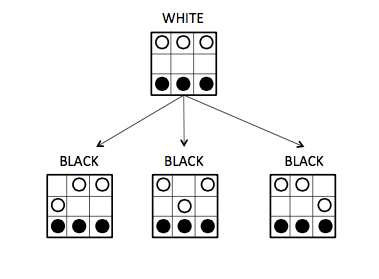
For this assignment, you will:
This week’s assignment uses a tree data structure to play a small chess-like game. You will build a tree representing all possible states that the game board can be in. You will then implement several different players that consult this tree to make moves as they play Hex-a-Pawn. The players include: a human player that asks the user for moves to make; a random player that picks possible moves at random; and a computer player that improves its strategy by learning from past mistakes. In the end, you will be able to run the different players against each other.
Before starting this assignment, read Section 12.11 in Bailey. This section describes the Hex-a-Pawn game as well as listing some steps to help you get started. This section also tells you that a complete game tree for 3x3 boards has 252 nodes. In the margin where it states this, you will find some helpful debugging advice (e.g. if your tree has 370 nodes then you have the wrong win test).
In this assignment, you must implement a GameTree class as well as three different classes corresponding to different types of players. Each of these player classes will implement the Player interface.
GameTree classYou are responsible for designing the GameTree class. This is a tree structure with potentially many children instead of just two. Think about the methods you will need for this class and how you can represent the structure.
The picture below shows the top two levels (i.e. the nodes at depth 0 and 1) of the game tree that results from a call to the constructor: new GameTree(new HexBoard(3, 3), HexBoard.WHITE)

The root node of the tree contains the starting board position (new HexBoard(3,3)) and the player is white (HexBoard.WHITE). Note that this is not a binary tree since it is possible for a node in the tree to have multiple children – each child corresponding to a legal action by the player.
You will construct three player classes: HumanPlayer, RandPlayer, and CompPlayer. Each player implements the Player interface. This interface has only one method:
public Player play(GameTree node, Player opponent);The play method takes in a GameTree corresponding to some configuration of the board and the opponent player. The return value of this method is the player who won the game. Inside play, you should check if the board configuration is a win for the opponent. If not, the player makes a move based on what type of player it is. After making a move, you should then call the opponent’s play method.
You will have to think carefully about how the Player classes interact with the GameTree class – this should inform what methods and instance variables you include in the GameTree class. You can also create a main method inside each Player class where you create two players and have them play a game – this will help you debug your code.
/common/cs/cs062/assignments/assignment08 directory. Familiarize yourself with these files before starting to work on this assignment. They are described briefly in the book, and the JavaDoc documentation is available here.GameTree class.HexBoard class (that class can compile on its own even though the Player class requires GameTree to be defined).main method in the HexBoard class to see an example of how to code up a game between two players.You will be graded based on the following criteria:
| Criterion | Points |
Efficient implementation of GameTree class
|
3 |
Correct HumanPlayer
|
3 |
Correct RandPlayer
|
3 |
Correct CompPlayer that trims tree over time
|
3 |
| General correctness | 3 |
| Appropriate comments (including JavaDoc) | 2 |
| Style and formatting | 2 |
NOTE: Code that does not compile will get a zero! Make sure that your code compiles before submitting.
As usual, export your project from Eclipse, and rename the resulting directory Assignment08_LastNameFirstName. Then use the submit script to submit it:
/common/cs/cs062/bin/submit cs062 asg08 Assignment08_Name